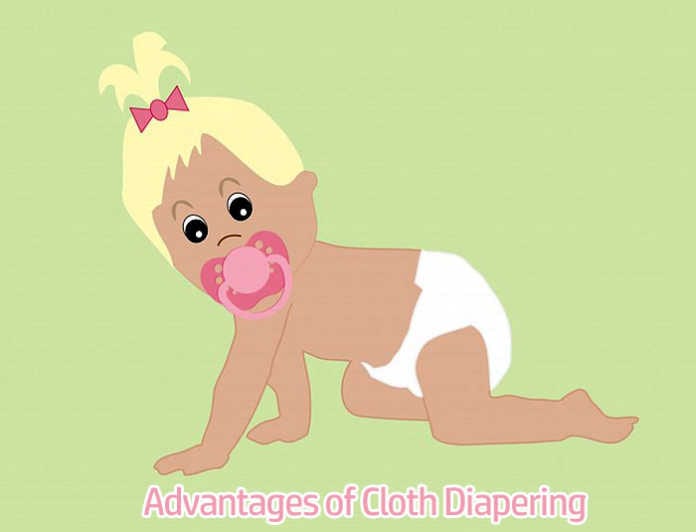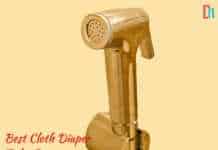
Advantages of Cloth Diapers: Welcome to the wonderful world of easy-to-use modern cloth diapers. Look at the many the advantages of cloth diapering have to offer.
Advantages of Cloth Diapers
- Use Cloth Diapers and save $$$: On average, you will spend $$$ on disposable diapers per child. Compare that to an average of $$ (that includes laundering expenses) for your first child’s diapering years using cloth diapers. A second and third child will cost much less, as many of the diapers can be re-used. Depending on the diaper system you use you can spend a little less or more than the disposed ones.
- Use Cloth Diapers and Reduce Diaper Rash! Diaper rash is seldom a problem when using cloth diapers. Cloth diapers are more breathable and cloth diapered babies are changed more often, as the diaper starts feeling damp after (on average) 4 hours. Disposable diapers mask the wetness, therefore child care providers and parents have no indication of how long the child has been wearing a wet or poopy diaper. This, together with the fact that disposable diapers become much hotter, allows more rapid bacterial growth which can cause diaper rash. If your baby has sensitive skin the reaction to the chemicals in disposable diapers may also contribute to diaper rash.
- Cloth Diapers are fast and easy to use – Unique Fastener/Line System: The new styles of cloth diapers now available are as easy to use as a disposable. The added effort of doing two additional loads of laundry per week is worth the many benefits for your child, your pocketbook and the environment.
- Cloth Diapers are cool and comfortable for baby! Cloth diapers are soft and comfortable made of natural, chemical free, very absorbent fibers. Most diapers are made of cotton. Sometimes hemp is used. Unlike disposable diapers, cloth diapers stay cool even on the hottest summer day.
- Potty Training is easier with Cloth Diapers: On average cloth diapered children potty train 6 months earlier than children wearing disposable diapers. Cloth diapers do not mask the sensation of wetness.
- Cloth Diapering fits any lifestyle: Cloth diapering easily adapts to fit even the busiest lifestyle or any full-time daycare situation.
- Cloth Diapers are the healthy alternative – Safer for new delicate skin: Cloth diapers don’t contain any of the harmful chemicals that disposables are loaded with. See “how dangerous are disposable diapers”.
How Dangerous Are Disposable Diapers?
- Your child will spend the first 2 1/2 to 3 1/2 years of his or her life in diapers. Disposable diapers are an easy way of diapering but are the possible health hazards these diapers pose worth the simplicity?
- Male infertility: Disposable diapers could be the cause of the sharp rise in male infertility over the past 25 years. It is thought that disposable diapers heat up boys testicles to such a degree that it stops them from developing normally.
- Sodium Polyacrylate, which is linked to Toxic Shock Syndrome and can therefore no longer be used in tampons, is the super absorbent gel in disposable diapers. You can find the little “gel balls” on the skin of your baby’s bottom. It is interesting to note that employees in factories manufacturing sodium polyacrylate suffer from female organ problems, slow healing wounds, fatigue and weight loss.
- TBT (TRIBULYTIN): In May 2000 Greenpeace found TBT in Pampers® Baby Dry in Germany. TBT is one of the most toxic substances ever made. It harms the immune system and impairs the hormonal system. There is speculation that it could cause boys to become sterile.
- DIOXIN Traces of the carcinogen: Dioxin have been found in disposable diapers. Dioxin causes liver disease, immune system suppression, and genetic damage. It is a byproduct of bleaching with chlorine gas and is banned in most countries. Unfortunately, the USA still allows it.
- Asthma: In 1998 a study showed that childhood respiratory problems, including asthma, might be linked to inhaling the mixture of chemicals emitted from disposable diapers.
- UTI Infections in Baby Girls: Also there seems to be on the rise with increased use of disposable diapers especially baby girls.
- Babies poorly developed outer skin layer absorbs about 48 chemicals: If you use disposable diapers & wipes and standard baby products. This can be greatly reduced by using cloth diapers and natural baby products.
- Every child adds a minimum of 6500 disposable diapers (30% of which is non-biodegradable) to our landfills. Included in the soiled diapers are many pounds of raw fecal matter. Viruses found in the feces can pose a threat to our water supplies and wildlife, by seeping through cracks that sometimes develop in landfills.
- The manufacturing of disposable diapers poses another threat to our environment, requiring large quantities of wood pulp (trees) and dangerous complex chemical substances, which leave behind many harmful byproducts.
Compare all that to the resources used to make and clean three to five dozen cloth diapers with no raw fecal matter!)
Many of the experienced parents we spoke with before Isabelle arrived laughed at the thought of using cloth diapers. Cloth diapers were thought of as a nice thing to save the planet but WAY too much work. Not true in our experience. We actually found using BumGenius cloth diapers to be not much more difficult than buying then bringing thousands of disposable diapers out to the trash can every week. We wouldn’t do it any other way.








